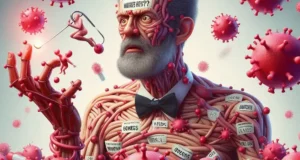Imagine a village where a fire has broken out. People are willing to help—some offer buckets, others bring blankets—but without water and tools, nothing changes. Then a massive water tank arrives, filled and ready, with pipes stretching into every house. Suddenly, help is not just a promise—it’s power in motion.

When AIDS emerged in the early 1980s, the world was stunned. The first question everyone asked was: “AIDS, where did it come from?” Scientists later traced it to a chimpanzee virus (SIV) that likely crossed into humans in Central Africa through the hunting of bushmeat. But even as the mystery of its origin was slowly solved, the bigger crisis unfolded: millions were infected, and most had no access to treatment.

The Global Fund functions like a giant engine fueled by international donations—governments, philanthropists, corporations, and individuals. It collects resources and then channels them into country-led programs to fight AIDS and related diseases. But unlike traditional aid organizations, the Global Fund does not dictate how money is spent.
It’s one thing to understand “AIDS, where did it come from?”, but entirely another to answer, “How do we stop it?” The Global Fund’s answer: put money where it matters most. That means:
- Supporting prevention tools like condoms, PrEP, and safe needle programs
- Expanding HIV testing to identify infections early
- Empowering vulnerable populations like young women, LGBTQ+ individuals, and people who use drugs
- Training healthcare workers, building labs, and strengthening entire health systems
So far, the results are staggering. By 2024, the Global Fund had saved over 59 million lives, and more than 24 million people were receiving HIV treatment with its support. In many parts of Africa and Asia, where HIV rates were once exploding, infection rates have dropped sharply thanks to Global Fund–supported programs.
But the Global Fund isn’t just about medicine—it’s about equity and access. It recognizes that fighting AIDS requires more than drugs. It requires confronting poverty, stigma, gender inequality, and weak infrastructure. That’s why many of its grants also support education campaigns, legal reforms, and community mobilization.
Imagine the Global Fund as the bloodstream of the global AIDS response—it doesn’t create the medicine, but it delivers it to the cells that need it. Without that steady flow, even the best strategies and innovations would stall.
And while the early question of “AIDS, where did it come from?” gave us valuable insights into the virus’s journey from chimpanzees to humans, the Global Fund helped answer the next question: “Where should we go from here?”
The answer: toward health systems that leave no one behind.
Today, the Global Fund continues to be a vital force in the push to end AIDS as a public health threat by 2030. It funds innovation, partners with governments, and responds quickly to emerging challenges like co-infections and drug resistance.
So when the story of AIDS is told—from the jungles of Central Africa to clinics in remote villages—the Global Fund will stand as the heart that kept hope alive, proving that with enough will and unity, humanity can turn even the deadliest diseases into history.




